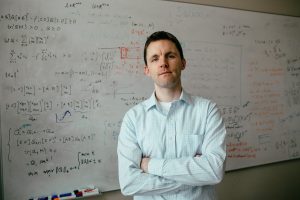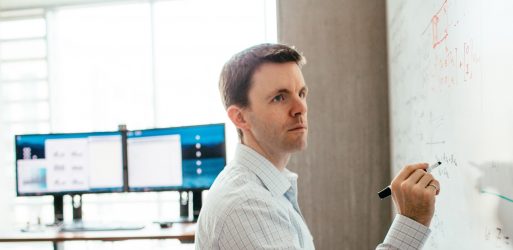With support from a prestigious National Science Foundation CAREER award, Laurent Lessard plans to improve the algorithms and computer software that keep the modern world running smoothly.
His approach draws on control engineering principles to help design optimization algorithms.
“There’s a fundamental difference in philosophy in designing an engineering system compared to the current state of machine learning,” says Lessard, an assistant professor of electrical and computer engineering at the University of Wisconsin–Madison and faculty member in the optimization group at the Wisconsin Institute for Discovery. “I’m trying to approach algorithms from an engineering standpoint.”

Machine learning algorithms are ingrained in many aspects of everyday life, and the simple bits of code that help computer programs make predictions based on patterns in large data sets usually perform remarkably well. When algorithms do make errors, oftentimes the consequences aren’t catastrophic—for example, very little harm is done if a program fails to recommend relevant products on an online shopping website.
However, machine learning extends well beyond recommendation systems. “If you build a bad bridge, you are putting human lives at risk. Is the same true if you build a bad algorithm? It depends on what you’re building an algorithm for,” says Lessard.
Increasingly, algorithms drive systems that do have the potential to wreak havoc if designed incorrectly.
Already, for example, algorithms protect our financial information by helping banks identify fraudulent credit card charges. Self-driving cars rely on algorithms to recognize their surroundings and avoid crashes. The power grid uses machine learning algorithms to predict future electricity supply and demand, especially as home solar energy becomes more common.
“Right now, machine learning is like a big bag of tricks… When there’s a new problem, I dig into my bag and try different things until something works.”
Algorithms are indispensable for many critical infrastructure systems, yet the process for creating them is still more of an art than a science.
“Right now, machine learning is like a big bag of tricks,” says Lessard. “When there’s a new problem, I dig into my bag and try different things until something works.”
Because individual coders might have their own distinct “bags of tricks” or apply different criteria to evaluate how effectively an algorithm performs its task, it’s possible that the best tools aren’t being used for some machine learning jobs.
Lessard wants to change that.
Using his background in control theory, the branch of engineering that deals with dynamical systems and feedback, Lessard intends to improve algorithms by leveraging the same design principles that underlie such products as thermostats and airplane autopilots.
“If we think about algorithms as control systems, we can use that engineering discipline for their analysis and synthesis,” says Lessard.
Lessard plans to create new guides for practice to help implement more rigorous standards in algorithm analysis, creation, and tuning. Although bridging the gap between two traditionally disparate fields can be challenging, both control system engineers and computer programmers have, so far, been receptive to Lessard’s ideas.
“I think everybody recognizes that we need to do something,” said Lessard.
To help educate as many people as possible, Lessard makes all of the materials for the courses he teaches freely available on his website and notes that thousands of people already have downloaded his lectures. He is also an active blogger, using his platform to promote engagement with science and mathematics by posting quirky puzzles with detailed solutions.
The grant provides $467,300 of support over five years.
This story originally appeared at engr.wisc.edu. Author: Sam Million-Weaver.


You must be logged in to post a comment.